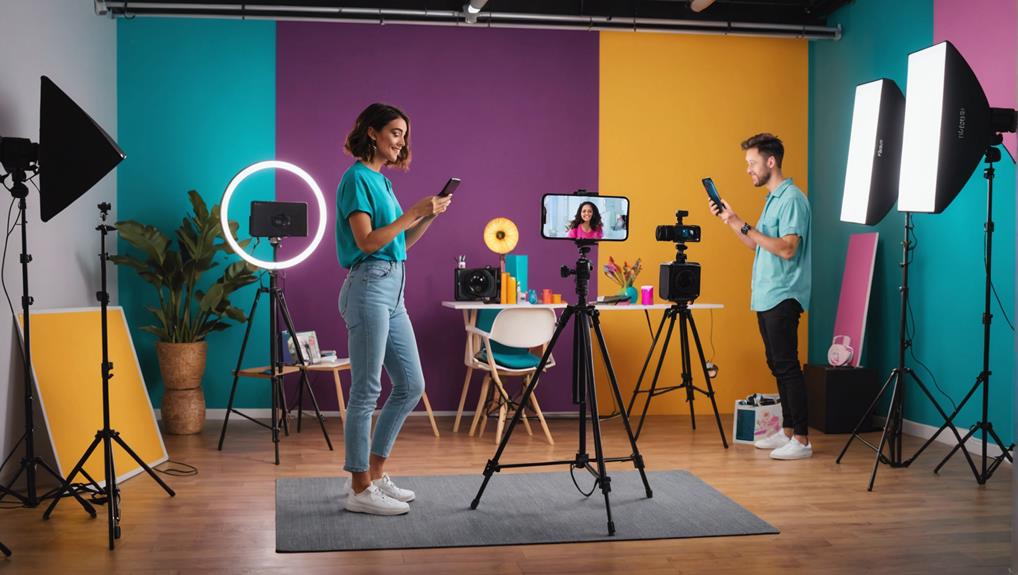Seamless brand-influencer collaboration hinges on strategic alignment of audience demographics and authentic content creation. Prioritize engagement metrics and audience alignment to identify genuine influencers using tools like BuzzSumo. Offer creative freedom to enhance engagement but guarantee regular content reviews maintain brand consistency. Establish open communication and structured feedback loops for efficient collaboration, and employ analytical tools for precise performance tracking. Long-term partnerships not only boost engagement but also build trust and brand recall through co-created content that aligns with brand values. Compliance with regulations and transparent communication are essential. Explore further strategies to enhance these collaborative efforts.
Key Takeaways
- Ensure audience demographics align with target market for effective brand-influencer collaborations.
- Prioritize engagement metrics over follower counts to assess influencer effectiveness.
- Establish open communication channels and regular check-ins for real-time feedback and adjustments.
- Provide influencers with creative freedom to enhance engagement and authenticity.
- Use influencer marketing tools for streamlined identification and assessment of suitable candidates.
Influencer Selection Criteria
When selecting influencers for brand collaboration, it is often paramount to guarantee that their audience demographics closely mirror your target market, as this alignment enhances both the relevance and effectiveness of marketing campaigns.
The influencer selection criteria should prioritize engagement metrics over mere follower counts, focusing on likes, comments, and shares to ascertain an active and involved audience. This strategic approach aids in identifying influencers whose reach can genuinely impact your brand’s objectives.
Authenticity is another vital factor in the selection process. By reviewing an influencer’s past content, brands can assess consistency in voice and messaging, assuring alignment with brand values.
This authentic connection fosters trust and credibility, amplifying campaign relevance. Influencers with a genuine interest in your industry or product category are more likely to produce content that resonates deeply with their audience, facilitating strategic brand alignment.
Utilizing influencer marketing tools such as BuzzSumo and Upfluence can streamline the identification process, allowing brands to efficiently pinpoint candidates who meet these rigorous criteria.
Authentic Content Creation
In the domain of brand-influencer collaboration, authentic content creation emerges as a vital strategy for enhancing audience engagement and brand loyalty. By integrating storytelling techniques, influencers can share personal anecdotes that resonate with their followers, increasing relatability and resulting in a 20% boost in conversion rates. Authentic content fosters trust and loyalty, as 86% of consumers trust recommendations from influencers who genuinely connect with the brand.
| Aspect | Impact | Strategy |
|---|---|---|
| Storytelling Techniques | 20% increase in conversion rates | Personal anecdotes for relatability |
| Visual Consistency | 70% more likely to engage | Align with brand aesthetics |
| Creative Freedom | 5x higher engagement | Collaborative content creation |
| Trust and Loyalty | Enhanced audience engagement | Regular content review for brand alignment |
Collaborating with influencers during the content creation process not only supports creative freedom but also guarantees alignment with brand values, leading to up to five times higher engagement. Maintaining visual consistency with the brand’s aesthetic is essential, as 70% of consumers are more likely to engage with cohesive content. Additionally, regularly reviewing influencer content for alignment with brand guidelines is critical for building a positive brand image. These collaboration strategies, when strategically executed, ensure that the content resonates with the audience, driving higher conversion rates and reinforcing brand loyalty.
Communication Protocols
Building upon the foundation of authentic content creation, effective communication protocols become a significant element in optimizing brand-influencer partnerships. Establishing open communication channels from the outset guarantees that clear expectations are set, fostering collaboration and enhancing campaign success.
This strategic alignment is vital, as it sets the stage for transparency and trust, key components in any successful partnership.
To maintain alignment on objectives, regular check-ins are fundamental. These allow for real-time feedback and adjustments, addressing concerns promptly while keeping both parties aligned on goals.
Additionally, defining specific communication protocols, such as designated channels for issue resolution, further enhances transparency and trust throughout the collaboration process.
Contracts play a critical role in this dynamic, clearly outlining deliverables, compensation, and rights. This clarity prevents misunderstandings and guarantees that both brands and influencers remain on the same page.
Furthermore, implementing feedback loops encourages continuous dialogue. This enables both parties to adapt strategies based on performance and audience responses, guaranteeing the campaign remains relevant and effective.
Performance Metrics Tracking
As the digital landscape becomes increasingly competitive, tracking performance metrics emerges as a critical component in evaluating the effectiveness of brand-influencer collaborations. Precise tracking of performance metrics guarantees that brands can assess the impact of their partnerships through measurable outcomes.
By focusing on key performance indicators (KPIs) such as engagement rates, click-through rates, and conversions, companies can determine the success and return on investment (ROI) of their campaigns.
Utilizing advanced tools like Google Analytics and social media insights, brands can access extensive data on audience interactions, offering a granular view into the effectiveness of influencer collaborations. This data-driven approach allows companies to align their marketing objectives more closely with real-time insights, leading to more informed strategic adjustments.
Establishing clear KPIs tailored to specific campaign goals is paramount for measuring success. Brands can track performance using the following metrics:
- Engagement Rates: Measure audience interaction and content resonance.
- Click-Through Rates: Evaluate the effectiveness of call-to-action elements.
- Conversions: Assess direct impact on sales and lead generation.
- Reach and Impressions: Gauge overall visibility and awareness.
Regular analysis and adjustments based on these metrics enhance campaign effectiveness, guaranteeing that marketing strategies remain agile and goal-oriented.
Long-Term Collaboration Benefits
Long-term collaborations between brands and influencers markedly enhance audience engagement, as evidenced by a fivefold increase in engagement rates compared to one-off partnerships.
This sustained interaction not only fosters deeper connections but also guarantees consistent brand messaging, which is essential for building trust and improving brand recall.
Moreover, the strategic advantage of maintaining these enduring relationships lies in the ability to craft more compelling narratives that resonate with audiences, thereby driving higher conversion rates and reinforcing brand loyalty.
Enhanced Audience Engagement
When brands engage in sustained partnerships with influencers, the strategic benefits extend far beyond mere visibility. Long-term collaboration with effective influencers greatly boosts brand awareness and credibility, achieving 5x higher engagement rates than one-off partnerships.
This approach allows for precise audience targeting, as the influencer’s followers become more familiar with and receptive to the brand. Through seamless collaboration, brands can harness authentic narratives that resonate emotionally with audiences, enhancing brand messaging and fostering genuine connections.
The advantages of long-term collaborations can be summarized as follows:
- Increased Engagement: Sustained influencer relationships drive deeper audience connections, leading to enhanced engagement rates and higher conversion rates.
- Enhanced Brand Recall: Consistent brand presence through these partnerships boosts brand recall by 30%, as audiences repeatedly encounter the brand in a trusted context.
- Emotional Resonance: Effective influencers craft narratives that emotionally resonate with their followers, positioning the brand as a trusted ally rather than a transient promoter.
- User-Generated Content: Long-term collaborations facilitate the creation of user-generated content, which amplifies brand messaging and increases audience engagement across platforms.
Consistent Brand Messaging
A key strategic advantage of consistent brand messaging through long-term influencer collaborations lies in the establishment of a cohesive and recognizable brand identity. This cohesion is achieved by collaborating with influencers to co-create content that aligns with the brand’s core values and goals. Such collaborations foster a uniform tone across various platforms, enhancing brand integrity and authenticity—key factors in bolstering consumer trust.
By maintaining consistent brand messaging, brands can enhance brand recall by as much as 30%, ensuring that their audiences remember and relate to them more effectively.
The strategic benefits of these partnerships extend beyond mere recognition. Long-term influencer partnerships amplify audience engagement, increasing it up to five times compared to transient, one-off collaborations.
This sustained engagement allows brands to explore deeper into creating narratives that resonate profoundly with their target audiences, improving conversion rates by 20%. Moreover, ongoing collaborations provide the flexibility to adapt brand messaging based on audience feedback and evolving trends, while still preserving a consistent brand identity.
This dynamic adaptability not only reinforces brand recall but also positions the brand to respond strategically to market changes, thereby securing a lasting footprint in consumers’ minds.
Compliance and Transparency Measures
Guaranteeing compliance and transparency in brand-influencer collaborations is critical for maintaining trust and credibility in the digital marketplace. Adhering to the Federal Trade Commission (FTC) guidelines is a non-negotiable aspect of influencer marketing platforms, as it mandates influencers to clearly disclose paid partnerships. This not only aligns with disclosure guidelines but also fosters audience trust.
Brands must strategically implement ethical practices, guaranteeing compliance is a priority, thereby enhancing long-term brand loyalty and audience engagement.
Key measures to guarantee compliance and transparency include:
- Regular Content Review: Systematically examining influencer content for adherence to disclosure guidelines helps brands avoid potential legal issues and maintain compliance.
- Clear Communication: Influencers should use explicit language, such as #ad or #sponsored, allowing followers to easily understand the nature of endorsements, thereby promoting transparency.
- Transparency Reports: Providing detailed accounts of collaboration nature can enhance credibility, reinforcing robust brand partnerships and fostering deeper audience connections.
- Full Disclosure: Ethical practices, including transparency in compensation and product gifts, are essential for building long-term brand loyalty and increasing audience engagement.
Frequently Asked Questions
How Can Brands Ensure Influencers Align With Their Core Values?
Brands can guarantee influencers align with their core values through rigorous influencer vetting, focusing on brand alignment and ethical considerations. Establishing transparent communication fosters authentic partnerships, guaranteeing content authenticity, audience resonance, and mutual benefits for long-term relationships.
What Are Effective Ways to Manage Influencer Disputes During Collaborations?
Effective management of influencer disputes involves dispute resolution through clear communication strategies, contract clarity, and expectation management. Employ mediation techniques, performance reviews, and feedback loops to guarantee reputation preservation, relationship building, and strategic contingency planning for potential conflicts.
How Should Brands Handle Negative Feedback Received on Influencer Content?
Brands should employ negative sentiment analysis and proactive communication strategies to manage influencer-related feedback. Implement crisis management techniques with transparency and honesty, monitor audience perception, use constructive feedback loops, and refine social media response tactics to safeguard brand reputation.
How Can Brands Effectively Use Influencer Insights in Campaign Planning?
Brands can leverage influencer insights by analyzing performance metrics, ensuring content authenticity, and aligning with market trends. Prioritizing audience engagement, relationship building, and creative freedom while considering target demographics, platform selection, and campaign longevity enhances brand voice effectiveness.
What Steps Can Brands Take to Protect Against Influencer Fraud?
To protect against influencer fraud, brands should implement thorough influencer vetting, utilize fraud detection tools, guarantee contract transparency, assess performance metrics, verify audience authenticity, conduct engagement analysis, safeguard brand reputation, adhere to compliance guidelines, secure payments, and establish robust reporting mechanisms.
Conclusion
The integration of seamless brand-influencer collaboration strategies necessitates a multi-faceted approach. Prioritizing influencer selection criteria guarantees alignment with brand values, while authentic content creation fosters genuine audience engagement. Establishing clear communication protocols enhances mutual understanding and efficiency. Rigorous performance metrics tracking enables data-driven decision-making and optimization. Recognizing the benefits of long-term collaborations can provide sustained value. Adhering to compliance and transparency measures safeguards ethical standards and builds trust. Collectively, these strategies enhance brand visibility and influencer impact.




